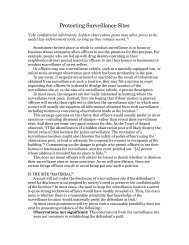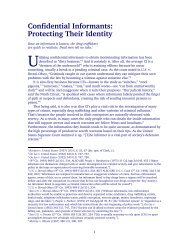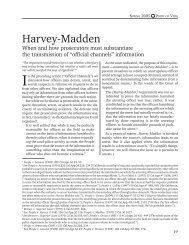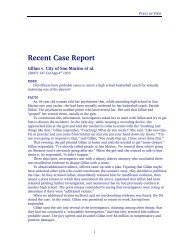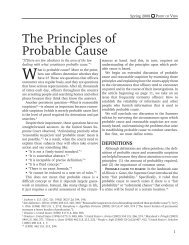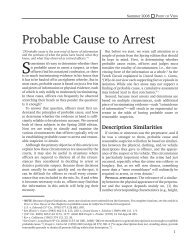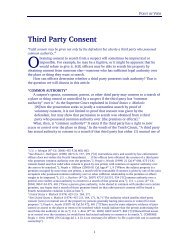Executing Search Warrants - Alameda County District Attorney's Office
Executing Search Warrants - Alameda County District Attorney's Office
Executing Search Warrants - Alameda County District Attorney's Office
You also want an ePaper? Increase the reach of your titles
YUMPU automatically turns print PDFs into web optimized ePapers that Google loves.
or radio once the search warrant was issued.” 29 If, however, the judge made any changes<br />
in what officers may search or seize, officers must be notified of those changes before<br />
they begin the search. 30<br />
VIDEOTAPES OR PHOTOS OF ENTRY, SEARCH: For various reasons, officers should<br />
consider videotaping the entry and search. For one thing, the United States Supreme<br />
Court has pointed out that videotaping might be useful as a “quality control” measure<br />
and to prove that officers conducted the search in a proper manner. 31 In addition, it may<br />
help protect officers against false claims that they damaged or destroyed property during<br />
the execution of the warrant. And if the case goes to trial, and if the location of the<br />
evidence is relevant, videotapes or photographs will enable officers and prosecutors to<br />
show the jury exactly where it was found and in what condition. 32<br />
SECURING THE PREMISES<br />
After officers make entry, the first step is to take control of the premises. This is<br />
considered standard practice because, as the U.S. Supreme Court observed, “The risk of<br />
harm to both the police and the occupants is minimized if the officers routinely exercise<br />
unquestioned command of the situation.” 33 It will also minimize the risk that the<br />
suspects will escape, destroy evidence, or otherwise impede the search. 34<br />
In most cases, officers take control by quickly spreading out throughout the premises<br />
in order to locate and identify everyone there. As the California Supreme Court<br />
explained, because of the “risk posed by residents or familiars of the household who may<br />
be involved in the criminal activities therein,” officers “have a legitimate interest in<br />
determining the identity and connection of a person present at or entering a search<br />
site.” 35<br />
Note that any weapons discovered in plain view may be temporarily seized for officer<br />
safety even if they were not contraband or seizable under the warrant. 36<br />
Detaining and pat searching occupants<br />
Detentions and pat searches of people on the premises are permitted as follows.<br />
INVESTIGATIVE DETENTIONS: <strong>Office</strong>rs may detain a person if they reasonably believed<br />
he would be arrestable if any of the listed evidence was found. 37 Like all seizures, the<br />
29 (1 st Cir. 1986) 808 F.2d 864, 868-9. ALSO SEE People v. Rodriguez-Fernandez (1991) 235<br />
Cal.App.3d 543, 553-4.<br />
30 See Guerra v. Sutton (9 th Cir. 1986) 783 F.2d 1371, 1375.<br />
31 Wilson v. Layne (1999) 526 US 603, 613. ALSO SEE Marks v. Clarke (9 th Cir. 1996) 102 F.3d<br />
1012, 1032, fn.37 [“A review of our cases suggests that we have assumed without deciding that<br />
videotaping of the execution of a valid search warrant is lawful.” Citations]; U.S. v. Stowe (7 th Cir.<br />
1996) 100 F.3d 494, 500 [“(V)ideotaping a scantily-clad woman, even only incident to the search,<br />
is grounds for a legitimate complaint.”].<br />
32 See People v. Smith (1994) 21 Cal.App.4 th 942, 951, fn.3; U.S. v. Stowe (7 th Cir. 1996) 100 F.3d<br />
494, 499; People v. Hines (1997) 15 Cal.4 th 997, 1041-2; U.S. v. Carpenter (9 th Cir. 1991) 933 F.2d<br />
748; U.S. v. Myers (8 th Cir. 1994) 21 F.3d 826, 828 [officers made a videotape of the search of a<br />
farm on which marijuana was growing, “showing the setup of the farm and the seizure of<br />
approximately 393 marijuana plants and large amount of marijuana-growing equipment”].<br />
NOTES: The videotape is not a public record and may not be inspected by, or released to, the<br />
news media. See Oziel v. Superior Court (1990) 223 Cal.App.3d 1284, 1294 [videotape is not<br />
subject to the California Public Records Act because it is being held on behalf of the court which is<br />
not subject to the Act].<br />
33 Michigan v. Summers (1981) 452 US 692, 702-3.<br />
34 See Michigan v. Summers (1981) 452 US 692, 702-3.<br />
35 People v. Glaser (1995) 11 Cal.4 th 354, 368.<br />
36 See People v. Gallegos (2002) 96 Cal.App.4 th 612, 628, fn.13.<br />
6



